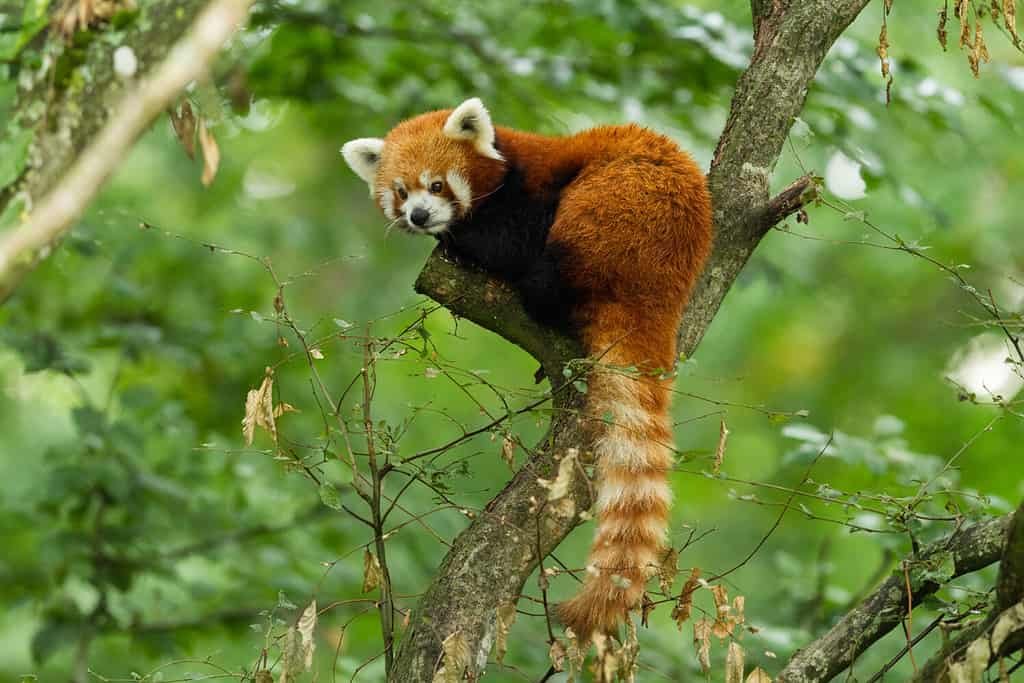When considering pandas, the giant panda bear (Ailuropoda melanoleuca) usually comes to people’s minds. As one of the rarest animals in the world, the panda is easily one of the most distinguishable. With their cuddly black-and-white appearance, many people praise them for their cuteness. Many people associate bamboo with the panda, but few know about how the panda digests their main meal and what happens to it afterward. This article will discuss panda poop and everything you’ve ever wanted to know about it as well as the panda’s unique digestive system.
What Does Panda Poop Look Like?
A regular panda poop contains shredded bamboo stalks and leaves. It may appear green in color because of all of the plant matter. Large chunks of bamboo are present in the fecal matter because the panda’s digestive system is not able to process all of the plant matter properly. If they have eaten meat recently, the poop will be darker in color and stronger in fragrance.
How Pandas Poop

Pandas shed their gastrointestinal lining to assist in the replacement of the microbes they lose.
©Bryan Faust/Shutterstock.com
Pandas feed for the majority of their day. They eat 12 hours a day. A research team studied pandas and their digestion. During winter and spring, pandas consumed less than one percent of leaves, whereas in August, they consumed leaves 60 percent of the time. Pandas’ digestive tracts are more closely related to that of a carnivore rather than an herbivore. These researchers discovered that when the pandas eat more bamboo leaves rather than the stalks, their digestive systems suffer. During the time when pandas are consuming plant matter that irritates their intestinal lining, they have developed a tactic to help.
They shed their gastrointestinal lining. This results in mucous stool. Pandas do this to assist in the replacement of the microbes that they are losing. It resembles a sort of reset. The plant matter passes quickly through their digestive system, not allowing enough time for microbes to break down the matter properly. The shedding of their lining helps assist them in the digestion and fecal processes of the bamboo stalks and leaves.
How Frequently Pandas Poop
The giant panda poops quite often. They will poop around 40 times a day and will produce around 50 pounds of feces a day. Pandas poop so much that scientists find them in the wild but following trails of feces. Experts say that pandas poop every 15-20 minutes, most of it being undigested bamboo. That is a lot of poop!
Does Panda Poop Smell?
Similar to other animal’s feces, panda poop does not smell great. However, it does not smell as bad as other animal feces. Healthy panda poop has a less potent smell and possesses a bamboo fragrance. When a panda is having digestive issues, their feces reflect it. When examining the excrement of a panda dealing with digestive issues, one researcher described the texture as gooey and the smell as “ghastly.” Panda feces have a more potent odor when they have more mucus. The amount of mucus increases when the panda consumes more of the food that irritates its digestive lining.
What Do Pandas Eat?

The giant panda’s diet is 99% bamboo.
©lotushkco/ via Getty Images
Pandas have one of the most specialized diets on the planet. They feed almost exclusively on bamboo. Their diet is 99% bamboo, although they can be found occasionally eating leaves, eggs, and rodents as well. While this may seem like a boring diet, the giant panda does have some variety to their diet. They feast on 20 different varieties of bamboo.
The most interesting part of the giant panda diet is that it does not correlate with their gut bacteria. The giant panda’s gut bacteria is not equipped to process all of the plant matter that they consume properly. Studies show that pandas only digest around 17 percent of the bamboo that they eat daily. This means that the majority of their energy goes to excreting that undigested bamboo.
Although other animals have evolved anatomically to have digestive systems that support the deconstruction of plant matter, the giant panda has not. Studies show that “the giant panda still retains a gastrointestinal tract typical of carnivores.” Not only does this contribute to their increased amount of waste because of undigested plant matter, but it also places them in an evolutionary dilemma.
Is Panda Poop Harmful?
Panda poop is not harmful to humans. In fact, the Wuhan Zoo has it on display and encourages its visitors to sniff it when they visit the panda exhibit. Its unique bamboo fragrance is something that is hard to describe and recognize without having smelled it for yourself. Additionally, panda poop has many beneficial uses.
Uses of Panda Poop
Surprisingly, the fecal matter of pandas is proving to be quite useful. Bamboo, which is the main food of a panda’s diet, is very high in fiber. It is so high in fiber that researchers in China are looking for paper mills to process the feces into high-quality paper. These researchers studied paper that was made from elephant poop, and they thought that panda poop could produce even better quality paper. While this use of panda feces has not yet been implemented, there is talk of using it for office paper and rolls of wrapping paper. The main goal of this use is to help recycle waste and create environment-friendly options for consumers. This process is already present in Thailand. The Chiang Mai Zoo produces and sells multi-colored paper produced by two of their pandas.
Besides being used for paper, panda poop serves another purpose. Scientists have discovered that panda poop contains bacteria that help break down plant matter and could be a new source of biofuels. Co-author of the study, Ashley Brown, states that panda poop is perfect for “optimizing the breakdown of the raw plant materials used to make the fuels.” Bacteria in panda feces show promising potential in the ability to break down tough plant material that is often found in switchgrass, corn stalks, and wood chips.
Do All Pandas Poop the Same?

Pandas lack microbes that allow for the proper digestion of plant materials.
©AB Photographie/Shutterstock.com
Although they differ in size and appearance, the red pandas’ diet is similar to that of the giant pandas. They also have a very specialized diet, consisting mostly of bamboo. Red pandas eat slightly less bamboo, which makes up only 85 percent of their diet. Red pandas also eat roots, succulent grasses, fruits, and insects. Studies that compare the diet and digestive system of both pandas show some stark differences. The study shows that pandas have gut bacteria that are closely related to black bears, whereas red pandas are more closely related to raccoons.
Despite their differences, both types of pandas lack microbes that allow for the proper digestion of plant materials. While less is known about the gut microbiota of the red panda, there are enough similarities to suggest that their digestive systems are similar and their pooping procedures are similar. However, the size and quantity of their poop varies. Giant pandas can poop up to 40 times a day, whereas the red panda poops their body weight in one week.
Panda Facts
Here are five fun facts about this incredible animal.
- Despite having heavy bones, pandas are very flexible.
- Almost all pandas belong to China.
- According to the San Diego Zoo, “Sometimes a female can be pregnant with two cubs, but only give birth to one — her body reabsorbs the other embryo.”
- Pandas are the most vocal of all of the bears.
- The giant panda’s digestive system more closely resembles that of a carnivore despite their diet mostly consisting of bamboo.
The photo featured at the top of this post is © iStock.com/wrangel
Thank you for reading! Have some feedback for us? Contact the AZ Animals editorial team.







